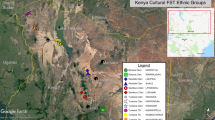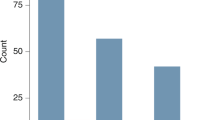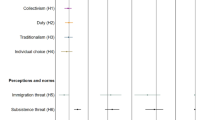Abstract
Humans distinguish between we-groups and they-groups, such as relatives versus strangers and higher-ups versus lower-downs, thereby creating crucial preconditions for favouring their own groups while discriminating against others. Reported here is the finding that the extent of differentiation between us and them varies along latitude rather than longitude. In geographically isolated preindustrial societies, intergroup differentiation already peaked at the equator and tapered off towards the poles, while being negligibly related to longitude (observation study 1). Contemporary societies have evolved even stronger latitudinal gradients of intergroup differentiation (survey study 2 around 1970) and discrimination (mixed-method study 3 around 2010). The geography of contemporary differentiation and discrimination can be partially predicted by tropical climate stress (warm winters, hot summers and irregular rainfall), largely mediated by the interplay of pathogen stress and agricultural subsistence (explanatory study 4). The findings accumulate into an index of intergroup discrimination by inhabitants of 222 countries (integrative study 5).
This is a preview of subscription content, access via your institution
Access options
Access Nature and 54 other Nature Portfolio journals
Get Nature+, our best-value online-access subscription
$29.99 / 30 days
cancel any time
Subscribe to this journal
Receive 12 digital issues and online access to articles
$119.00 per year
only $9.92 per issue
Buy this article
- Purchase on Springer Link
- Instant access to full article PDF
Prices may be subject to local taxes which are calculated during checkout




Similar content being viewed by others
Data availability
As indicated in the Methods, all data are available for visual inspection (Supplementary Information) and empirical analysis. SPSS data files for preindustrial and contemporary societies can be downloaded from https://hdl.handle.net/10411/YXI7WH. The author is prepared to provide clarifications if needed.
Code availability
The SPSS analysis scripts used in studies 1–5 are provided in the Supplementary Methods. The author is prepared to provide clarifications if needed.
References
Tajfel, H. Human Groups and Social Categories (Cambridge Univ. Press, 1981).
Triandis, H. C. Individualism and Collectivism (Westview, 1995).
Hofstede, G. Culture’s Consequences: Comparing Values, Behaviors, Institutions, and Organizations Across Cultures (Sage, 2001).
Alves, H., Koch, A. & Unkelbach, C. A cognitive–ecological explanation of intergroup biases. Psychol. Sci. 29, 1126–1133 (2018).
Van de Vliert, E. Climato-economic origins of variation in ingroup favoritism. J. Cross Cult. Psychol. 42, 494–515 (2011).
House, R. J., Hanges, P. J., Javidan, M., Dorfman, P. W. & Gupta, V. Culture, Leadership, and Organizations: The GLOBE Study of 62 Societies (Sage, 2004).
Van de Vliert, E. & Postmes, T. Climato-economic livability predicts societal collectivism and political autocracy better than parasite stress does. Behav. Brain Sci. 35, 94–95 (2012).
Van de Vliert, E. Climato-economic habitats support patterns of human needs, stresses, and freedoms. Behav. Brain Sci. 36, 465–521 (2013).
Fincher, C. L. & Thornhill, R. Parasite stress promotes in-group assortative sociality: the cases of strong family ties and heightened religiosity. Behav. Brain Sci. 35, 61–79 (2012).
Fincher, C. L., Thornhill, R., Murray, D. R. & Schaller, M. Pathogen prevalence predicts human cross-cultural variability in individualism/collectivism. Proc. R. Soc. B 275, 1279–1285 (2008).
Talhelm, T. et al. Large-scale psychological differences within China explained by rice versus wheat agriculture. Science 344, 603–608 (2014).
Talhelm, T., Zhang, X. & Oishi, S. Moving chairs in Starbucks: observational studies find rice–wheat cultural differences. Sci. Adv. 4, eaap8469 (2018).
Van de Vliert, E. & Van Lange, P. A. M. Latitudinal psychology: an ecological perspective on creativity, aggression, happiness, and beyond. Perspect. Psychol. Sci. 14, 860–884 (2019).
Tipps, D. C. Modernization theory and the comparative study of societies: a critical perspective. Comp. Stud. Soc. Hist. 15, 199–226 (1973).
Inglehart, R. & Baker, W. E. Modernization, cultural change, and the persistence of traditional values. Am. Soc. Rev. 65, 19–51 (2000).
Chown, S. L. & Gaston, K. J. Areas, cradles and museums: the latitudinal gradient in species richness. Trends Ecol. Evol. 15, 311–315 (2000).
Harcourt, A. H. Humankind: How Biology and Geography Shape Human Diversity (Pegasus, 2015).
Murdock, G. P. & White, D. R. Standard cross-cultural sample. Ethnology 8, 329–369 (1969).
Murdock, G. P. & Wilson, S. F. Settlement patterns and community organization. Ethnology 11, 254–295 (1972).
Ross, M. H. Political decision making and conflict: additional cross-cultural codes and scales. Ethnology 22, 169–192 (1983).
Ross, H. M. The Culture of Conflict (Yale Univ. Press, 1993).
Conway, L. G. III et al. Ecological origins of freedom: pathogens, heat stress, and frontier typography predict more vertical but less horizontal government restriction. Pers. Soc. Psychol. Bull. 43, 1378–1398 (2017).
Hofstede, G. Culture’s Consequences: International Differences in Work-Related Values (Sage, 1980).
Van Staveren, I., Webbink, E., De Haan, A. & Foa, R. The last mile in analyzing wellbeing and poverty: indices of social development. Forum Soc. Econ. 43, 8–26 (2014).
Van Staveren, I. & Pervaiz, Z. Is it ethnic fractionalization or social exclusion, which affects social cohesion? Soc. Indic. Res. 130, 711–731 (2017).
Van de Vliert, E. Climatic imprints on personality. Nat. Hum. Behav. 1, 864–865 (2017).
Van de Vliert, E., Welzel, C., Shcherbak, A., Fischer, R. & Alexander, A. C. Got milk? Freedoms evolved from dairying climates. J. Cross Cult. Psychol. 49, 1048–1065 (2018).
Parker, P. M. National Cultures of the World: A Statistical Reference (Greenwood Press, 1997).
United Nations Development Programme Human Development Report 2004: Cultural Liberty in Today’s Diverse World (Oxford Univ. Press, 2004).
United Nations Development Programme Human Development Report 2002: Deepening Democracy in a Fragmented World (Oxford Univ. Press, 2002).
United Nations Development Programme Human Development Report 2006: Beyond Scarcity--Power, Poverty and the Global Water Crisis (Palgrave Macmillan, 2006).
Nettle, D. Explaining global patterns of language diversity. J. Anthropol. Archaeol. 17, 354–374 (1998).
Alesina, A., Devleeschauwer, A., Easterly, W., Kurlat, S. & Wacziarg, R. Fractionalization. J. Econ. Growth 8, 155–194 (2003).
United Nations Development Programme. Human Development Indices and Indicators: 2018 Statistical Update (United Nations Development Programme, 2018).
Sutin, A. R., Stephan, Y. & Terracciano, A. Perceived discrimination and personality development in adulthood. Dev. Psychol. 52, 155–163 (2016).
Kruglanski, A. W. The Psychology of Closed Mindedness (Psychology Press, 2004).
Hewstone, M., Rubin, M. & Willis, H. Intergroup bias. Annu. Rev. Psychol. 53, 575–604 (2002).
Gebauer, J. E. et al. Cultural norm fulfillment, interpersonal belonging, or getting ahead? A large-scale cross-cultural test of three perspectives on the function of self-esteem. J. Pers. Soc. Psychol. 109, 526–548 (2015).
Mischel, W. Toward a cognitive social learning reconceptualization of personality. Psychol. Rev. 80, 252–283 (1973).
Diamond, J. Guns, Germs, and Steel: The Fates of Human Societies (W. W. Norton, 1997).
Laitin, D. D., Moortgat, J. & Robinson, A. L. Geographic axes and the persistence of cultural diversity. Proc. Natl Acad. Sci. USA 109, 10263–10268 (2012).
Van Lange, P. A. M., Rinderu, M. I. & Bushman, B. J. Aggression and violence around the world: a model of climate, aggression, and self-control in humans (CLASH). Behav. Brain Sci. 40, e75 (2017).
Turchin, P., Adams, J. M. & Hall, T. D. East–west orientation of historical empires and modern states. J. World Syst. Res. 12, 219–229 (2006).
Triandis, H. C. The self and social behavior in differing cultural contexts. Psychol. Rev. 96, 506–520 (1989).
Gelfand, M. J. et al. Differences between tight and loose cultures: a 33-nation study. Science 332, 1100–1104 (2011).
World Bank Atlas (World Bank, 1970).
Acknowledgements
Helpful comments on drafts of this article were received from L. G. Conway, S. Daan, C. K. W. De Dreu, H. C. Santos, W. Scholl and P. A. M. Van Lange. The author received no specific funding for this work.
Author information
Authors and Affiliations
Contributions
E.V.d.V. designed and performed the studies, analysed the data, and wrote and edited the manuscript.
Corresponding author
Ethics declarations
Competing interests
The author declares no competing interests.
Additional information
Peer review information Primary handling editor: Aisha Bradshaw.
Publisher’s note Springer Nature remains neutral with regard to jurisdictional claims in published maps and institutional affiliations.
Extended data
Extended Data Fig. 1 Joint effects of pathogen stress and agricultural subsistence on gender discrimination in 157 contemporary societies (R2 = .72).
Horizontally viewed, both slopes tell that higher pathogen stress increases gender discrimination, albeit less so in areas with much agriculture (B(153) = .29, p < .001, CI = .16 to .42 for the upper slope) than in areas with little agriculture (B(153) = .65, p < .001, CI = .49 to .82 for the lower slope). Vertically viewed, both gaps between slopes tell that more agriculture increases gender discrimination, albeit less so in areas with high pathogen stress (B(153) = .36, p < .001, CI = .22 to .49 for the right gap) than in areas with low pathogen stress (B(153) = .72, p < .001, CI = .56 to .89 for the left gap).
Supplementary information
Supplementary Information
Supplementary Methods and Supplementary Results for studies 1–5 and Supplementary Table 1 for study 1.
Supplementary Data 1
Supplementary data for studies 1–5.
Rights and permissions
About this article
Cite this article
Van de Vliert, E. The global ecology of differentiation between us and them. Nat Hum Behav 4, 270–278 (2020). https://doi.org/10.1038/s41562-019-0783-3
Received:
Accepted:
Published:
Issue Date:
DOI: https://doi.org/10.1038/s41562-019-0783-3



